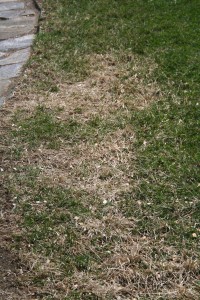No matter how long the winter, spring is sure to follow. – Proverb
Okay, weeds in your lawn might not be a problem right now. But it always amazes me how we go from yearning to see any growth at all to being two weeks behind in weeding. So in the interest of getting ahead, here are some things you can do to prevent future problems.
Tune up your mower
My number one recommendation? Give your mower a tuneup now. If you bring your mower to a shop, now is a great time to avoid the spring rush. Mine was dropped off last week and we won’t get it back for another two. That window only gets longer the closer we get to the time when the grass starts to grow in earnest. Last year we waited too long and couldn’t start mowing when needed.
If nothing else, get those blades sharpened.
Are you more of a do-it-yourselfer? This clip’s for you:
Need convincing? Sharp blades:
- cut rather than shred grass
- are easier on the grass, making it more likely to resist insects, diseases, and drought
- decrease fuel use by up to 20 – 30% compared to dull blades

What else can you do now?
The best time to seed is in the fall, but if you have bare spots, go ahead and throw some seed down, ideally right before some snow flies (I know, I want to believe it’s over too, but I’ve also lived in New York for most of my life, so…). This practice is called dormant overseeding and can help you get a head start on the season. It’s a good practice to put down twice the seed rate when dormant overseeding.
Avoid pitfalls
It’s spring fever. That is what the name of it is. And when you’ve got it, you want — oh, you don’t quite know what it is you do want, but it just fairly makes your heart ache, you want it so! – Mark Twain
No recreational mowing
We often see what we have dubbed “recreational mowing” across the state – the practice of mowing the lawn on nice days before the grass has come out of dormancy. Besides being a waste of gas, there is the risk of compacting the soil by running the mower over damp spring soils. Soil compaction makes it harder for spring rains to soak in and grass roots to grow nice and long. Weak, thin grass is more susceptible to weed issues.
Timing is important
Once the grass starts growing, set your mower to its highest setting. The longer the leaf blades, the deeper the roots, providing a buffer against drought, diseases, and insect damage. Taller grass also creates shade, making it harder for weed seeds to germinate.
Warm, rainy days can lead to significant growth, leading to mowing anxiety. Mowing when soils are saturated, however, and can lead to rutting and compaction. Try to wait until the soil has had a chance to dry.
On the flip side, if you wait too long, you can end up leaving clumps of grass clippings, which can block out the sun and seal in the moisture, leaving the turf susceptible to humidity-loving diseases. Under these conditions, collect clippings and compost them, if possible.
Hold off on fertilizers
Spring fertilization promotes top growth at the expense of root growth. Grass needs deep roots as a buffer against summer heat, drought, insect damage, and diseases. Unless you are maintaining high quality, high traffic turf, such as on golf putting surfaces, wait until the fall to fertilize.
We’ll let Cornell Turf Guy, Frank Rossi, have the last word.
For year-round information on lawn care, visit Lawn Care: The Easiest Steps to an Attractive Environmental Asset.
And get out there and enjoy the coming springtime as much as we will!

